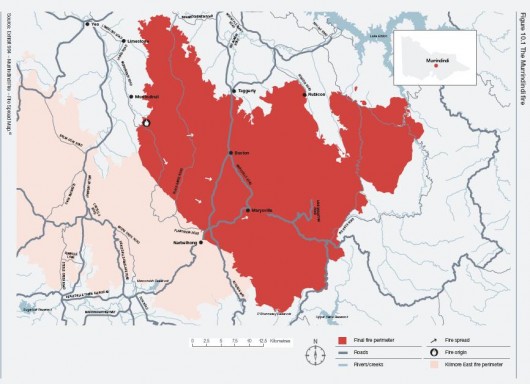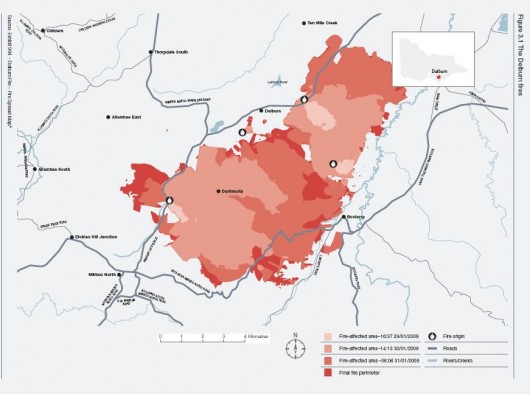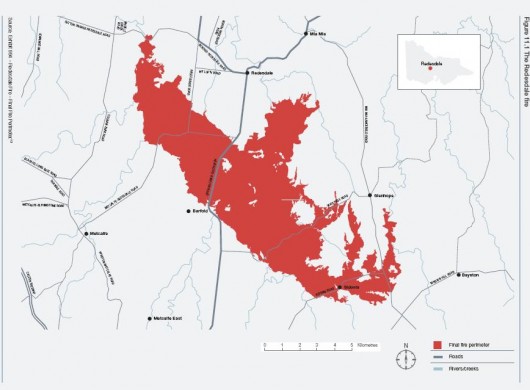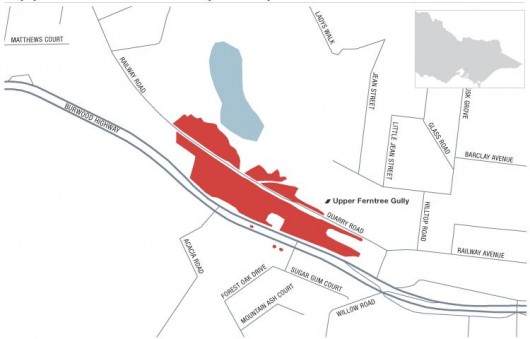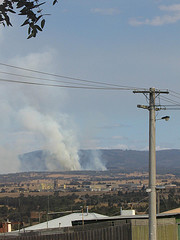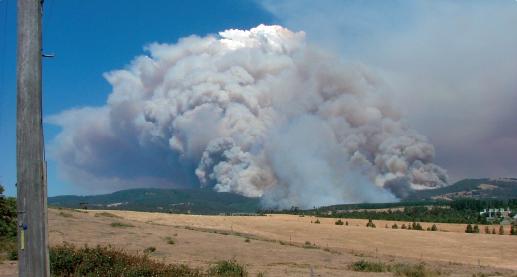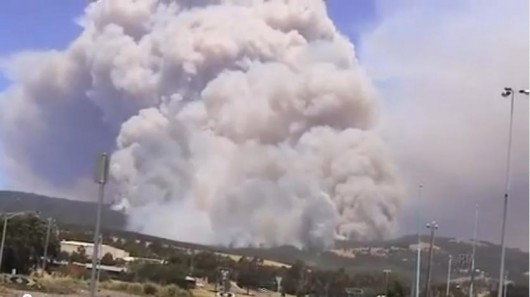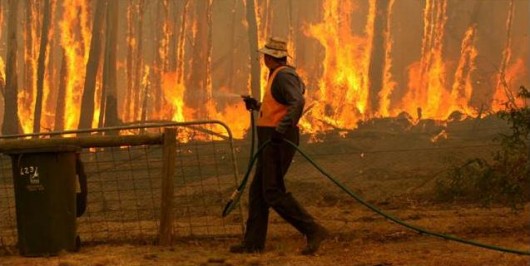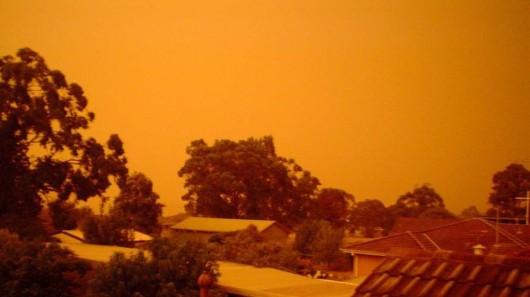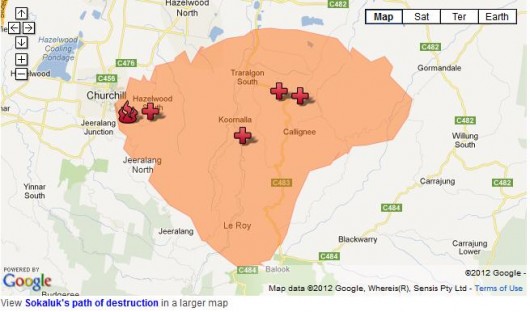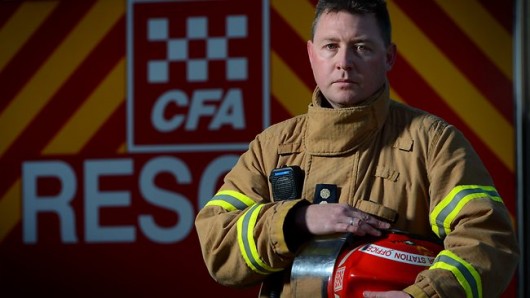Churchill Fire: when firefighters recruit misfits
Monday, August 27th, 2012The Bush Arson Misfit’s Lure..
..the evening news media dramatises a forthcoming government declaration of a‘Total Fire Ban’. Next day yep, dry and hot, then early afternoon wind picks up. Yep, having mapped target, and with no-one around, opportunity to be ‘Bushfire Hero’…
.
7th Feb 2009, 1:30pm – a pine plantation near Churchill, West Gippsland:
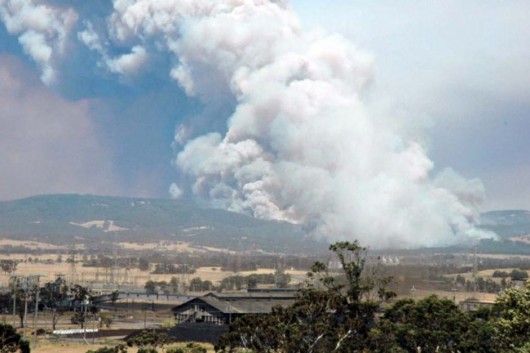 2009 Churchill Fire on Black Saturday – deliberately lit at 1:30pm
2009 Churchill Fire on Black Saturday – deliberately lit at 1:30pmSmoke billows skywards from the Glendonald Road bushfire at Churchill, West Gippsland, Victoria 20090207 [Source: KenBett submitted to ABC Contribute, ^http://www.abc.net.au/news/2009-02-07/smoke-billows-skywards-from-the-glendonald-road/287224]
.
Of the thousands of bushfires that burn Australia’s natural landscape each year, humans cause the vast majority, with somewhere around half of these being deliberately lit, that is, not by accident.
Bush Arson is a serious and heinous crime now systemic in bushfire-prone Australia, California and southern forested regions of Europe. It is committed usually by misfit serial offenders, yet despite the statistics, across all states in Australia from Tasmania to the Top End, the crime remains largely given lip service by governments.
Researchers at the Australian Institute of Criminology have assessed that there are many reasons why people light fires. While some want to relieve boredom by creating havoc and excitement, other arsonists crave recognition or attention. Some light fires out of anger or protest while others believe they are being altruistic by clearing what they see as dangerous fuel-loads. Sometimes there are multiple motives.
People who light fires for excitement will often stay around after the fire to view their handiwork, which suggests that fire crews should look around and talk to the people who are there watching. Knowing that some people light fires just so they can treated as a hero if they report the fire or put it out is also useful, especially for fire services screening new members.
Some of those people who light those fires do become members of fire services, and this needs to be a consideration in the firefighting recruitment process.
[Source: ‘Bushfire arsonists bored, want change’, by Anna Salleh, ABC Science Online, 20060522, ^http://www.abc.net.au/science/news/stories/s1636354.htm, accessed 20071001] .The 2009 Victorian Bushfires, collectively branded by the media as ‘Black Saturday’, involved far many more bushfires that the ones that ignited and reported by the media on Saturday 7th February 2009.
‘The number of fires that had not been extinguished rose from seven on New Year’s Day to 29 on 14 January. Then it doubled to 58 by 25 January and continued to steadily increase to 125 in the week before 7 February. By this time firefighting resources had been committed for a fortnight responding to new fires and attending to fires already contained or controlled.’
[Source: ‘The Number of Fires’ in Overview, Part One: ‘The January-February 2009 Fires’, Vol I: ‘The Fires and the Fire-Related Deaths’ p.4 citing the Department of Sustainability and Environment – Annual Report 2009 (TEN.201.001.0001) at 0047, in Final Report, July 2010, Vol. 1, p.20, by 2009 Victorian Bushfires Royal Commission, State Government of Victoria ].
According to the Victoria Country Fire Authority, of the fires that were not readily contained on or before 7 February, 14 of those 47 became ‘major fires’. On 7th February alone however, the CFA indicated there were a total of 1386 incidents reported on 7 February — 592 grass and bushfires, 263 structure fires and 156 reported incidents that were false alarms.
.
[Ed: Clearly the bushfire conditions were extreme (beyond the usual ‘Total Fire Ban’ severity), the number and distribution of bushfires were considerable and emergency resources were overwhelmed. So for bush arson to be committed on such a declared day was beyond arson; it was ‘pyroterrorism’. But the crime does not yet feature in the Crimes Act. It needs to be. The penalty needs to be equated to that which would be imposed upon a terrorist attempting or actually causing mass murder. It is past time that Australia’s lackadaisical and euphemistic term ‘fire bug‘ is cast to history. We owe this to the memory and respect of 173 people lost. What is significant is that of the 173 who died, most were due to either arson or powerline spark – both human caused].
.
The bushfires associated with Black Saturday that were selected to be investigated by the Victorian Royal Commission were on the basis of fires having caused the death of the 173 people and/or where significant damage had occurred.
.
2009 Bushfires investigated by the Royal Commission
The investigated bushfires numbered twelve and they were:
- Kilmore East Bushfire
- Murrindindi Bushfire
- Churchill Bushfire
- Delburn Bushfire
- Bunyip Bushfire
- Narre Warren Bushfire
- Beechworth-Mudgegonga Bushfire
- Bendigo Bushfire
- Redesdale Bushfire
- Coleraine Bushfire
- Horsham Bushfire
- Pomborneit–Weerite Bushfire
.
[Ed: NOTE: We include the suffix ‘bushfire’ above, unlike the Royal Commission in its literature which abbreviates ‘bushfire’ just to ‘fire’, or even drops the reference to fire completely, bless their imported cotton socks].
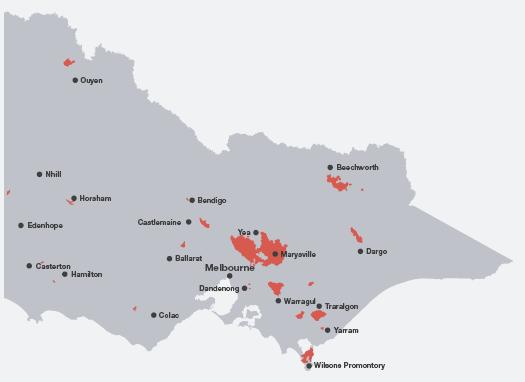 2009 Victorian Bushfires – Overview Map
2009 Victorian Bushfires – Overview Map
.
It is instructive to emphasise that the eventual naming of these fires was based on the point of origin, however on the day it had proven problematic during the overwhelming speed and complexity of the multiple simultaneous bushfire emergencies.
The lead item in the Terms of Reference for the Victorian Royal Commission was sensibly to inquire into ‘the causes and circumstances of these bushfires‘.
.
The Bushfires Deliberately Lit *
.
Of the above 12 bushfires investigated, those known or suspected to have been caused by arson or otherwise in obscure firefighting-speak ‘undetermined‘ or ‘unknown‘ were:
- Murrundindi Bushfire
- Delburn Bushfire
- Redesdale Bushfire
- Upper Ferntree Gully Bushfire
- Bendigo Bushfire
- Churchill Bushfire
.
*Various vague assessments as to cause included ‘suspicious’, ‘unknown’, ‘undetermined’, which in 2012 is unacceptable. Compare the term ‘undetermined‘ to any police investigation into an urban fire causing significant damage; such a vague dismissal would be publicly unacceptable. So in the absence of competent investigation, we shall presume bush arson. So half were caused by arson, which is in line with the Australian Institute of Criminology’s conclusions, above.
.
The Murrindindi Bushfire
With bushfire conditions extreme (temperature 44.6°C, humidity 8%, wind 46kph, Bushfire Index 110 – off the scale), the bushfire started about 14:55 on 7 February 2009, to the north of a sawmill in Wilhelmina Falls Road, Murrindindi. The cause was assessed as ‘suspicious’.
After the bushfire had merged with the Kilmore East Bushfire some 168,542 hectares had been burnt. Forty people were killed, another 73 people were injured, 538 houses were destroyed or damaged, mainly in and around Marysville, Narbethong and Buxton. The commercial centre of Marysville was razed to the ground. Firefighting resources involved 195 CFA and 311 NEO personnel, supported by 45 CFA appliances, 22 Networked Emergency Organisation (NEO)* appliances and 3 aircraft.
* [Ed: Networked Emergency Organisation? – a rather new convoluted bureaucratic term given to the Royal Commission to collectively represent a mix of disparate government agencies quickly cobbled together to deal with an emergency outside the control of the Country Fire Authority volunteer base].
.
The Delburn Bushfire
With bushfire conditions similarly extreme, albeit with a lower Fire Index of 52, this bushfire started as three separate ignitions in the Strzelecki Ranges on 28 and 29 January 2009:
- The Ashfords Road Bushfire – discovered on 28 January at about 4.00 pm, 2.5 kilometres north-north-west of Boolarra.
- The Creamery Road Bushfire – discovered at about 1.00 pm on 29 January, 2.5 kilometres east of Delburn.
- The Lyrebird Walk–Darlimurla Bushfire – discovered at about 3.30 pm on 29 January, 4 kilometres north of Mirboo North near Darlimurla.
.
[Ed: So each started under extreme bushfire conditions in the early afternoon]
.
The causes of both the above Creamery Road Bushfire and the Lyrebird Walk–Darlimurla Bushfire were assessed as ‘suspicious’ and the Victorian Police have since laid criminal charges against the suspected arsonist.
The three separate bushfires were not contained and ultimately merged. Increasing wind and changes in wind direction caused spotting and resulted in the bushfire spreading quickly east towards the outskirts of the townships of Boolarra and Yinnar. The surrounding townships included Mirboo North (population 1,300), Boolarra (pop. 600), Yinnar (pop. 600) and Churchill (pop. 5,000). Fortunately there were no fatalities or casualties, but 44 houses were destroyed maily on the outskirts of Boolarra, and some 6,534 hectares burnt out. Firefighting resources involved 597 CFA and 699 NEO personnel, supported by 112 CFA appliances, 103 NEO appliances and 14 aircraft.
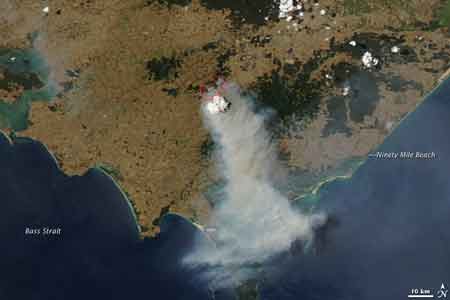 Delburn Bushfire 30th January 2009 from NASA satellite
Delburn Bushfire 30th January 2009 from NASA satellite
.
There had been a further three ignitions around the time (1) at the Delburn–Yinnar refuse transfer station, (2) at Ten Mile Creek Rd in a Hancock Victoria Plantation and (3) at Brewsters Rd, Yinnar. Each was either contained or burnt out without fire-fighting intervention.
.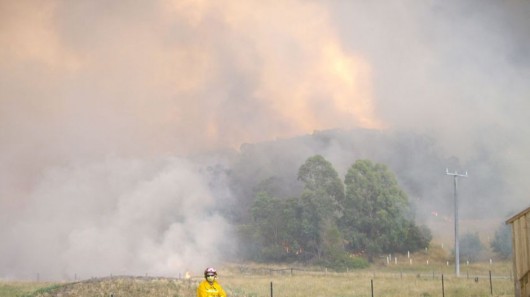 The 2009 Delburn Bushfire
A CFA firefighter runs out hose on Piggery Road at Boolarra 2nd February 2009.
(Photo by Greg Cahir)
The 2009 Delburn Bushfire
A CFA firefighter runs out hose on Piggery Road at Boolarra 2nd February 2009.
(Photo by Greg Cahir)
.
The Redesdale Bushfire
The Redesdale Bushfire started with similar bushfire conditions (temperatures reaching 44.7°C, humidity 7%, winds up to 50kph, Bushfire Index 87.2). The bushfire was reported at 3:11 pm on 7 February 2009.
According to the CFA, the ignition started in a creek bed on open farmland between the eastern bank of the Coliban River and the northern end of Summerhill Road, about two kilometres to the west of the township of Redesdale, about 95 kilometres north-west of Melbourne and 35 kilometres south-east of Bendigo. There were more than 100 houses in the bushfire area.
The cause of ignition of the Redesdale fire has been investigated but ‘not determined‘. Possible sources of ignition that have not been excluded are:
(a) ignition by a spark or hot exhaust system
(b) deliberate ignition
(c) ignition by farm operations
(d) ignition by a carelessly discarded cigarette butt
There was no evidence that any of these sources ignited the fire.
The bushfire burned towards the south-east for about 19 kilometres. It was the first of two bushfires in the region on that day, the second originating
in Maiden Gully, 8 kilometres north-west of Bendigo, around 4:20pm. Fortunately again there were no fatalities, but one reported casualty, 14 houses destroyed as well as more than 50 farm sheds and outbuildings, the Baynton church and a bridge, two olive oil plantations, a vineyard and two blue gum plantations, and 7,086 hectares were burned.
Firefighting resources required were 536 CFA and 127 NEO personnel, supported by 103 CFA appliances, 21 NEO dozers and 1 aircraft. Two CFA forward control vehicles were damaged in the course of the fire fight.
[Source: ‘Proposed RC key findings Redesdale’ by Royal Commission Taskforce, 20100211, Victorian Country Fire Authority website, ^http://www.cfaconnect.net.au/news/proposed-rc-key-findings-redesdale.html].
The Upper Ferntree Gully Bushfire
The Upper Ferntree Gully fire started on Saturday 7th February 2009 at about 3:40 pm in a suburban railway corridor through bushland between the Burwood Highway and Quarry Road. The bushfire conditions were extreme as with the entire State. By mid afternoon the wind had picked up and was gusting to 90kph, exacerbating the conditions.
The cause of the fire was not known. The fire initially spread by spotting south-east through scrubland between the Burwood Highway and Quarry Road near houses. By 4:30pm an air crane was requested and just after 5pm the Erikson Aircrane nicknamed ‘Elvis’ had made a number of rapid water drops on the fire, obtaining water from a nearby disused quarry, critically preventing the loss of houses and finally contained by 6pm. There were no fatalities or casualties and no houses were lost, but 4 hectares of regenerated scrubland was burnt.
 Erickson S-64 Air-Crane Helitanker (N179AC)
Erickson S-64 Air-Crane Helitanker (N179AC)
.
[To stop video and continue, click the pause button bottom left]
http://www.youtube.com/watch?v=uwzH8JSbqm4&feature=player_detailpage
.
Repeat Offenders? – same place lit again in January 2012: a hot, dry, windy afternoon, familiar turf
.
‘Members of the Upper Ferntree Gully cricket team were quick to report a grass fire that started near Quarry Rd. Firefighters from Ferntree Gully and Upper Ferntree Gully attended the blaze, which was reported about 7.15pm on Friday. Upper Ferntree Gully CFA captain Peter Smith said the fire started in vegetation-regeneration area near Quarry Rd.
“It was a grass and scrub fire at the old quarry of probably about a third of a hectare,” Mr Smith said. “Conditions were on our side but we wouldn’t have wanted it any hotter or windier.”
About five trucks responded to the blaze and Mr Smith praised the efforts of those who called 000.
“The people that spotted it were fantastic,” Mr Smith said. “They were local guys from the Upper Ferntree Gully Cricket Club I think, that helped us get in and assisted police.”
The cause of the fire is unknown and being investigated.‘
[Source: ‘Cricketers swing into action to stop Upper Ferntree Gully grass fire’, 20120130, by Laura Armitage, Free Press Leader, ^http://free-press-leader.whereilive.com.au/news/story/cricketers-swing-into-action-to-stop-upper-ferntree-gully-grass-fire/].
The Bendigo Bushfire
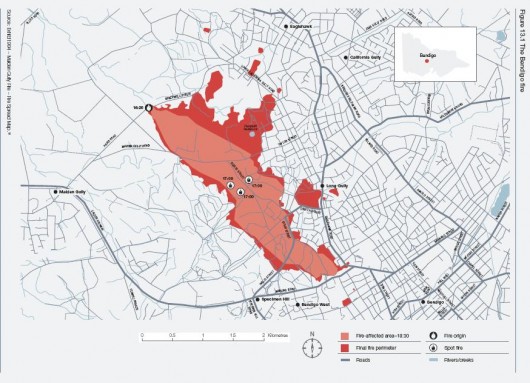 2009 Bendigo Fire Map Overview
2009 Bendigo Fire Map Overview
.
The Bendigo Bushfire started shortly after 4pm on Saturday 7th February 2009 in the tinder dry hilly bushland of Maiden Gully, 8 km north-west of central Bendigo. Bushfire conditions were extreme (temperatures up to 45.4°C, humidity 6%, winds up to 41kph and the Bushfire Index off the scale at 129). The ignition cause was assessed as ‘suspicious’ – the arsonist was classically upwind of the outskirts of targeted western Bendigo.
The bushfire burned through gently rolling country bordering the city’s western suburbs, where there are numerous former gold diggings that are now public open space interspersed between suburban blocks. One person died as a result, plus there were 41 reported casualties. Some 58 homes were destroyed and 341 hectares burned out.
Firefighting resources required were 152 CFA and 111 NEO personnel, which were supported by 30 CFA appliances, 31 NEO appliances and 3 aircraft.
.
The Churchill Bushfire
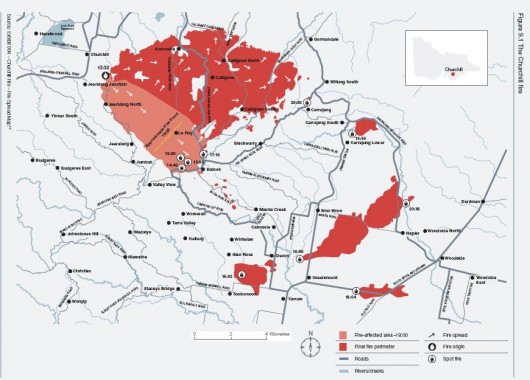 2009 Churchill Fire Map Overview
2009 Churchill Fire Map Overview
.
The Churchill Bushfire started at 1:30pm on Saturday 7th February 2009, 3km south-east of the Churchill fire station, from two separate ignitions respectively one at the intersection of Glendonald Road and the other at Jelleffs Outlet. The recorded ‘000’ call received from the public, not coincidently, at 13:32, two minutes later.
Like the other bushfires on that day, the climate background was characterised by a decade long El Niño drought, making the native vegetation tinder dry and so extremely flammable. It was a declared Total Fire Ban across Victoria. The Forest Fire Danger index was off the scale recorded at 103 at Latrobe Valley AWS at 4pm, the temperature reached 46.1°C an humidity at just 8% at the Latrobe Valley automatic weather station around 4pm, the humidity just 8%. The maximum winds recorded before the wind change were north-north-westerly
at 44 kilometres an hour at Latrobe Valley Automatic Weather Station at 15:43, before a south-westerly wind change came through.
Before 7th February, the Country Fire Authority and the Department of Sustainability and Environment had already been providing support in response to three separate bushfires which had started on 28th and 29th January and which had coalesced into one and became the Delburn Bushfire. It had been contained by 3rd February. Like the Delburn Bushfire, thge Churchill Bushfire was started on the one day by two separate ignitions by an arsonist. So then was the Churchill Bushfire a copy cat arson episode? Were the two somehow connected? Did both arsonists know each other?
At the time, the cause of the Churchill Bushfire was recorded as ‘suspicious’. It was in fact deliberately lit in two locations, outside the township of Churchill along a roadside next to and upwind of a pine plantation owned by Hancock Plantations Victoria at the foot of Walkers Hill. The tinder dry conditions fanned by a steady breeze meant the ignitions took hold quickly.
The recorded 000 call received from the arsonist himself at 13:32, two minutes later. Actual fire-fighting response was not documented in the Royal Commission report. It could well have been some hours before the blaze was fought. The following photos of the Churchill Fire are purportedly from the nearby township of Morwell looking south. They show the early minutes after the ignitions.
.
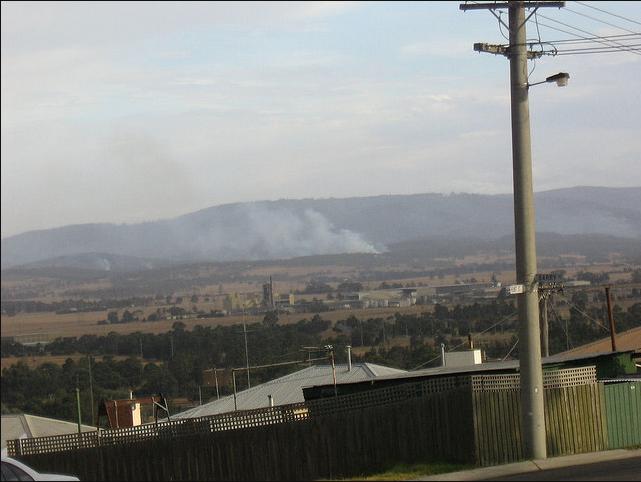 The very start of Churchill Bushfire
Photo taken looking south from Hunt Street, Morwell
The very start of Churchill Bushfire
Photo taken looking south from Hunt Street, Morwell
.
.
[Source of photos: ‘Nchalada’s Photostream’, Flickr, ^http://www.flickr.com/photos/nchalada/page2/, accessed 20120827, Ed: Due to their controversial nature, the many photos on this Flickr website may not be accessible for long.].
During the afternoon and early evening the fire travelled rapidly, affecting Jeeralang North, Balook, Le Roy, Koornalla, Callignee, Callignee North, Callignee South, Hazelwood South, Hazelwood North, Traralgon South, Devon, Yarram and Carrajung South. The final statistics confirm that firefighting resources deployed involved 409 CFA, 167 NEO personnel and 33 Hancock Victorian Plantations firefighters, supported by 76 CFA appliances, 29 NEO appliances and 4 waterbombing aircraft.
Although the fire was at its most destructive on 7th February, it was not reported as controlled until 19th February. Eleven people died as a result of the fire, plus an additional 35 casualties, 156 houses were destroyed, and more than 36,000 hectares were burnt.
[Source: ‘Smoke billows from the Churchill bushfire in the Gippsland region of Victoria’, ABC News, 20120213, ^http://www.abc.net.au/news/2012-02-13/smoke-billows-from-the-churchill-bushfire-in-the/3826566]About 1000 hectares of Bluegum plantations and 1700 hectares of Radiata Pine plantations owned Hancock Victorian Plantations by were burnt in the fires. An untold number of livestock and wildlife were also burned to death. In the nearby Delburn Fire, an arrest has been made but the outcome of that trial is not yet known at the time of publishing this article.
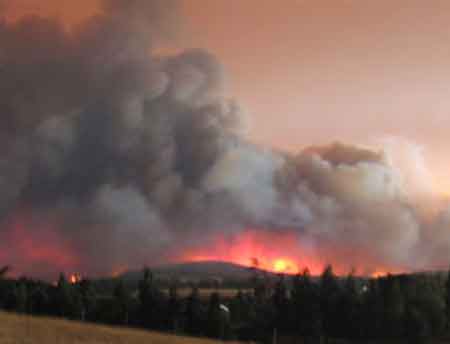 Plantations being incinerated in Churchill Bushfire
[Source: Hancock Watch, ^http://hancockwatch.nfshost.com/docs/09feb.htm]
Plantations being incinerated in Churchill Bushfire
[Source: Hancock Watch, ^http://hancockwatch.nfshost.com/docs/09feb.htm]
.
Recounting the Bushfire Horror
.
[Ed: Due to their online fickle nature, these videos may not be available here to view for long]
.
MY CHURCHILL BLACK SATURDAY.mov
[To stop video and continue, click the pause button bottom left]
.
Churchill fires, Glendonald Rd, 07/02/09
[To stop video and continue, click the pause button bottom left]
.
Churchill Fires 3:00 pm 07/02/2009 taken from Churchill near Monash Way
[To stop video and continue, click the pause button bottom left]
.
Churchill Fires 07/02/2009 taken from Glendonald Park 6:20 pm
[To stop video and continue, click the pause button bottom left]
.
Churchill Fires 07/02/2009 taken from Churchill 7:30 pm
[To stop video and continue, click the pause button bottom left]
.
Feb 1st 2009 (a week prior): ‘Residents remain on fire alert’
[Source: ‘Residents remain on fire alert’, by Jane Metlikovec, Herald Sun newspaper, 20090201, ^http://www.heraldsun.com.au/news/residents-remain-on-fire-alert/story-e6frf7jo-1111118724393].
‘Residents of fire ravaged Gippsland towns have been warned to remain alert despite cooler temperatures today. So far 27 homes around Boolarra and Mirboo North have been lost in the fires. (Ed: The Delburn Bushfire)
More than 400 firefighters from as far as Mildura are currently battling the 6300 hectare blaze with 113 fire trucks, 14 helicopters and 12 bulldozers. About 40 Boolarra and Mirboo North residents have spent the past two nights in emergency accommodation at Monash University in Churchill, after fire swept through their town on Friday.
More than 100 residents attended a community meeting in Churchill this morning to discover whether their properties had survived the weekend.
CFA spokeswoman Rachel Allen warned locals the blaze was far from being classified as safe, despite drizzle predicted and a top temperature of only 29 degrees. “Obviously the threat has diminished somewhat because of the cooler temperatures, but it as important now as it was a few days ago to keep yourselves aware,” Ms Allen said.
Peter McHugh from the Department of Sustainability and Environment agreed, saying the fire threat “was far from over,” and that residents need to remain vigilant for flying embers.
Mr McHugh said possible electrical storms predicted to hit the area later today are a cause of concern for emergency services.
The Delburn fires have claimed 27 homes, 59 sheds, 5 cars and a piggery since they began on Wednesday. Another home is also believed to have been lost yesterday, but fire crews have so far been unable to access the property, just outside Mirboo North. Almost 40 homes are still left without power, while water supply has been restored to Boolarra.
Department of Primary Industries staff are now counting livestock losses around the Boolarra area, and the number is believed to be substantial.
Latrobe City CEO Paul Buckley said it would take at least a year to rebuild Mirboo North and Boolarra.
“When the fires hit Toongabbie about three years ago that took six months to rebuild, and this one is much, much worse,” Mr Buckley said.
Boolarra evacuees housed in Monash University student accommodation units have shared their horror stories of the blaze that engulfed their town.
Tania Martin, 35, praised the efforts of her partner Dave Caldwell, 40, for saving both theirs and their neighbours’ house.
Ms Martin and her son Storm, 10, left their Boolarra home late Friday while Mr Caldwell stayed behind to defend the properties.
“I think he is an absolute hero,” Ms Martin said. Mr Caldwell worked for hours pumping water on both houses as flying embers showered all around him from the fire less than 100 metres away. But Mr Caldwell said the real heroes are the firefighters who have been working around the clock.
“Those guys and girls, you should watch them heading over the hill straight for the fire. It’s unbelievable,” Mr Caldwell said. “They are made of the right stuff, they are.”
Val Kingston, 68, and her husband recently moved to Boolarra from Melbourne for a “tree change.” “And now all the trees are gone,” Ms Kingston said.
Ms Kingston said leaving Boolarra lat Friday had been difficult. “It was the saddest sight I have ever seen looking over my shoulder as I drove away. I just thought “there goes my town.”
Ms Kingston praised the efforts of Monash University residential staff. The University purchased fans for the units where evacuees have set up makeshift homes. They have also provided tea and coffee and icy poles for the kids. “We can’t thank them enough,” Ms Kingston said.
A further 20 firefighters from Mildura and 18 firefighters from Ballarat arrived in Churchill this morning to relieve exhausted colleagues who have been stationed on the fire front for the past two days.
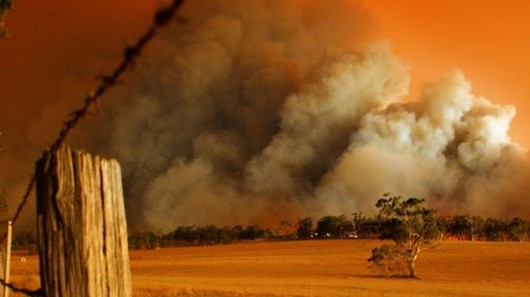 .
.
‘Churchill fire ‘threatening communities’
[Source: ‘Churchill fire ‘threatening communities’, Channel Nine News, 20090209, ^http://news.ninemsn.com.au/national/747731/glenhope-residents-warned-of-fire-threat] .The Churchill fire was threatening communities in south Gippsland late on Monday, fire authorities said. The 33,000 hectare blaze was threatening the community of Won Wron just north of Yarram, in south Gippsland at 5.30pm (AEDT) on Monday.
Residents of nearby Carrajung on the east side of Carrajung-Woodside Road were also expected to be impacted directly.
The Country Fire Authority also issued an urgent threat message at 4.15pm (AEDT) to residents near the Thomson Road area, Churchill, who were being directly hit by the fire. A CFA spokesman said the fire threat had increased as freshening winds picked up.
The death toll from the fires, which police believe were deliberately lit, in the area continued to rise. Nineteen people have now been confirmed dead in the region after the Churchill fires devastated the towns of Callignee, Hazelwood, Jeeralang and Koornalla in southwest Gippsland.
Nine people died in Callignee, one person was killed in Upper Callignee, four people died at Hazelwood, one at Jeeralang and four at Koornalla.
The Churchill fires south of the Princes Highway have so far burnt about 33,000 hectares, while the Bunyip Ridge fire, north of the highway, has razed 25,000 hectares.
Containment lines are also being established on the western and eastern flanks of the Bunyip blaze. Residents of Gembrook have also been warned to be vigilant, although the town is not currently under threat.
In the north of the state, fire around Dederang escalated significantly late on Monday afternoon, also threatening the towns of Beechworth and Yackandandah. The fire was spotting ahead of the main fire and ash and embers were threatening communities in Gundowring, Gundowring Upper, Glen Creek, Kergunyah South, Mudgeegonga and Running Creek. Authorities said some fires could take weeks to contain.
At least 750 homes have been destroyed and more than 330,000 hectares burnt out. The latest death toll is 131, which surpasses the toll from the 1983 Ash Wednesday bushfires, in which 75 people died in Victoria and South Australia, and the Black Friday bushfires of 1939, which killed 71.’
.
Misfit Profile of a Bush Arsonist
.
Brendan James Sokaluk, was in April 2012 found guilty of all 10 counts of arson causing death by the Victorian Supreme Court in Melbourne for deliberately lighting the Churchill Bushfire on 7th February, 2009. Sokaluk was an ex-volunteer firefighter with a local brigade of the Victorian Country Fire Authority (CFA) from 1987 to 1988, some twenty years prior.
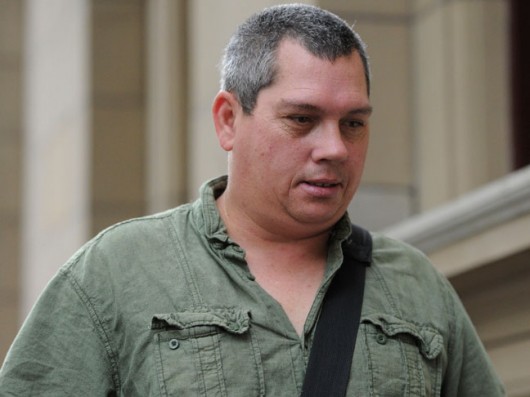 Brendan Sokaluk
Not the smartest bush arsonist, but then could he be?
Brendan Sokaluk
Not the smartest bush arsonist, but then could he be?
.
Sokaluk, then aged 39, claimed that his old sky blue Holden HJ sedan had apparently broken down on the road near where the fire started, next to a pine plantation where the Churchill Black Saturday fire had begun just minutes earlier.
He was the only outsider on the road. To the residents of Glendonald Road busily packing up their possessions and preparing to flee the raging fire, Brendan Sokaluk stood out. Dressed in shorts and sandals, he was frantically trying to restart his broken-down Holden, which was partially blocking the gravel road.
Once home, Sokaluk climbed on to the roof of his house so he could look back towards Glendonald Road and watch the fire burn.
Sokaluk told several lies to cover his tracks. He told one person he was on his way to a wedding, while to others he said he was visiting a friend in the area. As he was driven back to Churchill by a resident, Sokaluk was overheard telling his father on the phone that he had been in the area to visit a friend to get his chisel set back.
Days later Sokaluk was arrested on the following Friday 12th February on a local street while working delivering the local Latrobe Valley Express newspaper. Sokaluk was interviewed by police for about three hours both at the scene of the fire and in an interview room at a local police station. Police interviewed him and on the following day, Saturday 13th February, they returned him to Glendonald Road and to nearby Jelleff’s Outlet, where the fire had started and where the landscape was now blackened and burnt out.
 Ignition Points of the 2009 Churchill Bushfire
[Source: ‘Brendan Sokaluk – the boy who played with fire’, by Patrick Carlyon, Herald Sun, 20120321, ^http://www.heraldsun.com.au/news/true-crime-scene/brendan-sokaluk-the-boy-who-played-with-fire/story-fnat7jnn-1226305557238]
Ignition Points of the 2009 Churchill Bushfire
[Source: ‘Brendan Sokaluk – the boy who played with fire’, by Patrick Carlyon, Herald Sun, 20120321, ^http://www.heraldsun.com.au/news/true-crime-scene/brendan-sokaluk-the-boy-who-played-with-fire/story-fnat7jnn-1226305557238]
.
What emerged was that on the morning of 7th February, Sokaluk had picked up his father Kazimir in his distinctive sky blue Holden HJ and the pair drove to Morwell and Traralgon, visited auto and hardware stores, had lunch at KFC and bought lottery tickets. Kazimir Sokaluk said Brendan’s car was playing up and “running rough” but against his advice his son said he was “going up into the trees” because it was cooler there. Sokaluk also said he wanted to get a chisel set back from a friend named Dave who lived in that area. Another excuse was to access his apparent junk metal collection along Glendonald Road.
The police attempted a re-enactment and the field interview was recorded by video. Sokaluk admitted to police that he had started the blaze, but declared it had been an accident after he dropped cigarette ash out of his car window. He explained that the previous Saturday he had been driving slow, dawdling along in his car. “Looking for animals and stuff,” he said. Asked if he is familiar with the area, he replies: “It’s different `cause it’s not green no more. It’s all burnt out.” The detective asks “How do you know this area?” Sokaluk replied it was where he threw his piece of paper out the window.
“Part of my cigarette thing fell on the floor, so I got a bit of paper out to grab it and stuff… I thought it was dead and I’ve chucked it out the window, but I didn’t know it had lit up. I thought it was out when I threw the paper out the window.” Sokaluk told them. “I had no intention of this all to happen. Now I have to put up [with it] for the rest of my life and it makes me sad.”
The cigarette ash explanation was pivotal in what was a largely circumstantial case. But Sokaluk strenuously denied deliberately starting the fire. But then Sokaluk had told several lies to cover his tracks. He was a serial liar. Yet, without witnesses, evidence, a confession, proving bush arson is inherently difficult.
Prosecutor Ray Elston Senior Counsel argued that Sokaluk deliberately drove to bushland and started a fire on a day that had temperatures that reached nearly 45C. He was calculating enough to lie about his reasons for being in the area, to try to cover his tracks and to point the finger at others. Sokaluk tried to disguise his crime by claiming to police that it was an accident, lying about his reasons for being in the area and trying to point the finger at others, including making a false anonymous report to Crime Stoppers from his home computer blaming a Department of Sustainability and Environment worker for the fire.
Police managed to piece together Sokaluk’s movements on Black Saturday almost to the minute from phone records, witness accounts, shop receipts and CCTV footage. At 1.16 pm Sokaluk was in the IGA store in Churchill where he bought cigarettes before heading off into the Jeeralang Hills. Within 15 minutes a fire erupted in the hills and witnesses said that in tinder dry conditions the inferno tore through the bush seawards towards Yarram.
The Crown called 80 witnesses and its case was a mosaic of evidence that pointed to the guilt of Sokaluk. Mr Elston told the jury the accused had no reason to be in the area that day and if he was going to see Dave, who was home, he never got there.
“Why did he travel on a dirt road to get out there?” Mr Elston said to the jury in his summing up. “Why did he drive off that dirt road on to a graded track on the south side of Glendonald Road? A short distance from where the fire started Sokaluk’s car broke down and he was spotted at the side of the road by a Churchill CFA truck and then later picked up by a couple who drove him back to town.
Mr Elston told the jury:
”When the accused man arrives at that intersection there is no fire. ‘No one else is suggested to be present. When he leaves it’s ablaze. All causes save for deliberate ignition of this fire have been eliminated. ‘There is only therefore one irresistible conclusion to draw from the totality of the material, with respect, we suggest, and that is the accused man set those fires at two points.”
.
Neighbours saw Sokaluk on his roof watching the progress of the fire and for some never explained reason he later walked back into the fire area. A resident found him in his back yard and told him to shelter in his house a few minutes before the returning fire storm passed. The jury saw a pathetic picture of Sokaluk with a garden hose in his hand taken by the resident.
It was not until after he was charged with 10 counts of arson causing death that experts diagnosed him with autism spectrum disorder. Until then his family had believed his disability was result of a difficult birth. People in the Churchill area thought Sokaluk was a weirdo and called him” beanie boy” and other names and as soon as locals learned he was in the area where the bushfire erupted he became the prime suspect.
Sokaluk’s barrister Jane Dixon SC during the trial painted a picture of a harmless individual, a “simpleton” whose autism set him apart from others in the community – a “lights out and no-one home” type of personality. “He’s a bit of a misfit really, but nevertheless he muddled along in his own way, muddled along OK with a bit of help from his mum and dad, comfortable enough with his own company, his dog, his hobbies, his obsessions.”
After leaving school, where he had been bullied, Sokaluk worked in a series of jobs before becoming a gardener at Monash University. He did that job for nearly 18 years. Sokaluk spent his days watching kids TV and collecting scrap metal with his dog. Neighbours would hear Sokaluk playing Bob the Builder and Thomas the Tank Engine tapes as he worked in his shed, where he liked to tinker with scrap metal and other junk he had found dumped in the area. Sokaluk’s neighbour Patricia Hammond would sometimes talk to him over the back fence. He would talk to his dog as if he was talking to a child, she said during the trial.
. [Sources: ‘Arsonist Watched Black Saturday Blaze’, by Daniel Fogarty, AAP, 20120320, ^http://www.australianews.com.au/story?cityid=d1de82e1-fce9-4f45-9541-79d83e888155&storyid=6d0bddeb-0aab-4594-9b5a-81735aba0373; ‘Former CFA trainee guilty of Black Saturday arson deaths’, by Norrie Ross, Herald Sun, March 20, 2012, ^http://www.heraldsun.com.au/news/true-crime-scene/former-cfa-trainee-guilty-of-black-saturday-arson-deaths/story-fnat7dhc-1226305059485].
Justice Paul Coghlan of the Victorian Supreme Court sentenced Sokaluk stated in his summing up: “The event was terrifying for all involved in the fires, whether directly or otherwise,” he said. “For the victims, these were and are life-changing events and no sentence that I impose can compensate for their loss.”
Yet Justice Paul Coghlan of the Victorian Supreme Court sentenced Sokaluk to a non-parole custodial sentence of just 14 years. That is one and half years for each human death, excluding the millions of dollars in property damage and the horrific cruel burning to death of all people and animals, the other irreversible damage and tragedy – 156 homes with their personal possessions and memories, the livestock, 36,000 hectares of land, all the agricultural equipment and infrastructure, the forgotten wildlife.
[Sources: ‘Black Saturday arsonist jailed for almost 18 years’, by court reporter Sarah Farnsworth, Australian Broadcasting Corporation, 20120427, ^http://www.abc.net.au/news/2012-04-27/black-saturday-arsonist-sentenced-to-28holdholdhold29/3976564; ‘Black Saturday Churchill arsonist found guilty’, by Andrea Petrie, The Age, 20120320, ^http://www.latrobevalleyexpress.com.au/news/local/news/general/black-saturday-churchill-arsonist-found-guilty/2494544.aspx].
Sokaluk is one of Australia’s worst mass killers as Justice Coghlan concluded. Sokaluk should never be released. Yet his lawyers have already said they are likely to appeal. So who are the real villians? Sokaluk’s barrister Jane Dixon, SC, argued her client had autism and was a simple man and a misfit who was incapable of concocting a web of lies or deceit. Cold comfort to the victims. It was early afternoon on an extreme bushfire day. Sokaluk was upwind of and next to a pine plantation. Sokaluk knew what he was doing.
- Had he done it before but not been caught?
- Why did he leave the CFA?
- Had he been dismissed?
- In the CFA one is taught how to light fires for prescribed burning. What triggered his arson?
- Was it the devastation and attention that the Delburn Bushfire had created? It too was the cause of local arson.
- What was the news reporting like at the time?
- Did the media sensationalising serve to encourage Sokaluk as a dormant arsonist to copycat?
.
As aptly described by the Herald Sun’ Norrie Ross:
“He was a killer who brought death and devastation to his own community and left a vile legacy for LaTrobe Valley that will never be forgotten or erased.”
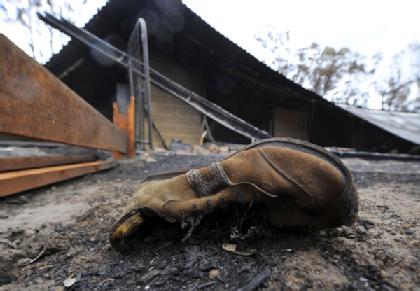 .
.
Royal Commission’s Findings into Bush Arson
.
One of the Royal Commission’s identified research gaps and priorities emanating out of its analysis was the extent of ‘Deliberately Lit Bushfires‘ and the ‘Causes of Fire-setting Behaviour‘. [Source: ‘Final Report – Summary’, July 2010, Vol. 1, p.20, by 2009 Victorian Bushfires Royal Commission, State Government of Victoria ]
Following from this, the Royal Commission made two specific recommendations to address what it terms ‘Deliberately lit Fires’. Those two recommendations read as follows:
.
ROYAL COMMISSION RECOMMENDATION 35
.
Victoria Police continue to pursue a coordinated statewide approach to arson prevention and regularly review its approach to ensure that it contains the following elements:
- High-level commitment from senior police
- A research program aimed at refining arson prevention and detection strategies
- Centralised coordination that includes comprehensive training, periodic evaluation of arson prevention strategies and programs, and promotion of best-practice prevention approaches
- A requirement that all fire-prone police service areas have arson prevention plans and programs, according to their level of risk.
.
ROYAL COMMISSION RECOMMENDATION 36
.
- The Commonwealth, states and territories continue to pursue the National Action Plan to Reduce Bushfire Arson in Australia, giving priority to producing a nationally consistent framework for data collection and evaluating current and proposed programs in order to identify and share best-practice approaches.
.
[Source: ‘Final Report – Summary’, July 2010, Vol. 1, pp.30-31, by 2009 Victorian Bushfires Royal Commission, State Government of Victoria ] .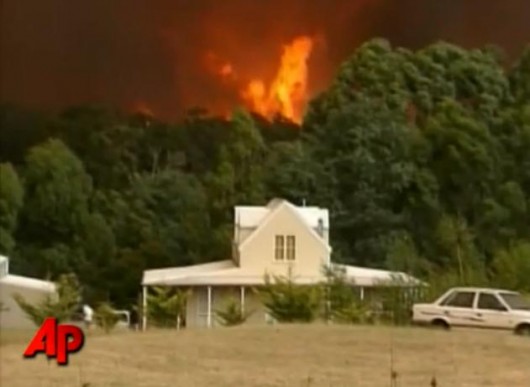
.
Misfits in Fire Fighting
.
It is disturbing that Sokaluk’s lawyer went to considerable effort and persuasion to try to have Sokaluk acquitted on mental illness grounds. Despite the adversarial nature of our legal system, the ego and public profile of lawyers should not be encouraged in spite of justice. Why was Sokaluk entitled to be represented by expensive and exclusive Senior Counsel? The bastard was at best entitled to Legal Aid. What was the total cost to Victorian taxpayers for his legal defence case? Why was the cost not made public?
Sokaluk was not just an arsonist. The scale and impact of his crime escalates him to being a pyroterrorist. But in Australia, the law lags reality. The maximum penalty for arson is 25 years custodial sentence, yet bushfire arson carries a maximum penalty of just 14 or 15 years. Sokaluk received just 14 years – the maximum penalty for arsonists are charged with criminal damage by fire or similar offences under the Bushfire Act or a manslaughter charge if someone dies as a result of the fire.
What is the rationale behind that discrepancy? It is archaic colonial legislation that sends a message that the value of Australia’s natural environment matters not. But when the bush burns, sometimes it lead to 173 human lives destroyed, as well as widespread calamity and wildlife extinctions.
Sokaluk’s 14 years custodial sentence translates to just 15 months in prison for each human he killed by fire. His sentence ignores his inflicting 35 human casualties, 156 houses destroyed, and more than 36,000 hectares of native forest and plantation forest burnt. Solaluk’s penalty is a judicial disgrace. The slap on the wrist penalty sends an sick and enticing message to dormant serial arsonists, that no matter how bad the fire you may light, at worst you get just 14 years. Solaluk should rot in prison. Yet legally technically, Sokaluk could have received the maximum penalty under the Victorian Forests Act of 1958 for ‘Lighting – intentionally or negligently and where authority should have been obtained – or maintaining a fire in the open air in a state forest or national park; failing to prevent the spread of a fire; leaving a fire without taking reasonable precautions to prevent it spreading or causing injury’.
The maximum penalty? 2 years
Australia’s arson laws and penalties are obscenely excusing of mass murder by being burned alive, horrific burn injuries, considerable and absolute property loss, large scale livestock loss by being burned alive, widespread wildlife habitat killing by being burned alive, livelong trauma, ruination of families and communities, immense suffering, widespread habitat destruction, and the irreversible destruction of a region in every sence of the meaning.
Yet Australian backward politicians dismissively treat bush arson akin to the playing with matches of a fire bug.
In the United States, ‘pyroterrorism’ is becoming seriously recognised. It is deemed to be the willful destruction of a Nation’s forests, farms and cities, through the use of fire. On 28th March 2005 the US Homeland Security held a press conference and revealed that they now had an anti-pyroterrorist taskforce. On April 1st, George W. Bush announced that “Anyone caught deliberately setting forest fires as an act of pyroterrorism will be dealt with the same way we treat other terrorists. Pyroterrorists are getting smarter and learning how to create bigger, more unstoppable forest fires… or there are copycats who want to do the same thing.
The Australian Institute of Criminology has concluded that half of Australia’s 20,000 to 30,000 vegetation fires each year are deliberately lit, costing the community $1.6 billion per year. So what is the Australian Government doing about this home grown terrorism? Nothing!
Many bushfire arsonist are disturbingly drawn from the very agencies entrusted to fight fires. But where are the statistics and what is being done about it?
How many misfits serve in volunteer fire fighting across Australia? How many have been psychologically tested as suitable? How many are subject to IQ tests before joining? None? How many dormant Sokaluks does Australian rural fire-fighting have in its ranks?
The Australian Government at federal and delegated state level neglectfully relies upon a low-cost volunteer base that is drawn from a goodwilling Australian culture, but which is dangerously under-resourced, underfunded and recipient of propaganda that perpetuates this.
Consequently, Australia’s non urban fire-fighting is so desperate for volunteers that dormant Sokaluks are unscrutinised, undetected and yet with their bushfire fighting training are trained to become the most deadly bush arsonists of all.
.
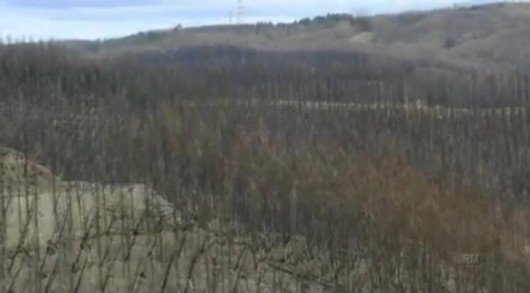 Armageddon aftermath of Sokaluk’s 2009 Churchill Bushfire Arson – he’ll be out in just 14 years
.
Armageddon aftermath of Sokaluk’s 2009 Churchill Bushfire Arson – he’ll be out in just 14 years
.
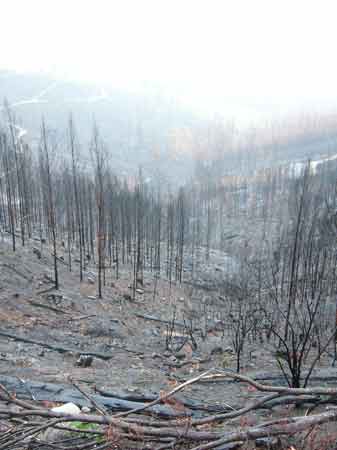 .
.
Further Reading
.
[1] ‘CFA member a suspect in Marysville arson: Reports‘, ABC TV ‘Lateline’ programme, 20090416, ^http://www.abc.net.au/lateline/content/2008/s2545144.htm
.
‘Police in Victoria are refusing to confirm reports that the major suspect in their investigation into the marysville bushfire is a member of the Country Fire Authority. Earlier this month detectives said they were closing in on the arsonist responsible. The Marysville fire claimed more than 30 lives. Fairfax Media has reported that the CFA fire-fighter is now considered the major suspect and has been questioned and released with investigations continuing. The CFA won’t comment except to say it’s working closely with the Phoenix Taskforce investigating the fires.’
.
[2] ‘CFA arsonist jailed for 22 months‘, Weekly Times, 20111216, ^http://www.weeklytimesnow.com.au/article/2011/12/16/421125_national-news.html
.
‘A CFA volunteer was jailed for 22 months today for starting a series of bushfires that had to be fought by his comrades in the local brigade. Justice Michael Tinney told Damian Lisle, 36, that any of the fires had the potential to cause catastrophic loss of life and property in one of Victoria’s highest bushfire danger areas, the Herald Sun reports.
Lisle drove around Mt Evelyn throwing lit pieces of paper from his car just days after the first anniversary of Black Saturday in which 173 Victorians lost their lives. Judge Tinney said Lisle started fires in dead-end streets near houses and in bushland and he did not hang around to see what happened. “You lit these fires and you left. Thereafter it was in the lap of the gods,” Judge Tinney said in his County Court sentence.
Lisle pleaded guilty to nine charges that on February 17, 2010, he intentionally caused a bushfire, and to counts of attempting to escape from custody and drink driving. Judge Tinney said Lisle had a history of mental and alcohol problems and at the time of his offending he was suspended from the Mt Evelyn CFA and facing the sack from his job as an assistant supermarket manager. After he was caught, Lisle told police he had drunk eight stubbies and added: “I remember being angry. I don’t know what about.”
Each of the arson counts faced by Lisle carries a maximum of 15 years jail. Judge Tinney said members of the Mt Evelyn brigade told the court that his crimes had a significant impact on CFA morale. The judge said the fact that Lisle was a CFA volunteer and had fought bushfires made him more aware of the danger to life and limb and both general and specific deterrence were important factors in sentencing.
During a court appearance at Melbourne Magistrates’ Court Lisle jumped the dock and tried to escape and the judge said two people were injured trying to restrain him. He set a maximum term of three years and 10 months.’
.
[3] ‘CFA volunteer charged with lighting fires‘, by Shelley Hadfield, Herald Sun 20090205, ^http://www.dailytelegraph.com.au/news/indepth/firey-charged-with-lighting-fires/story-e6frewn9-1111118767769
.
‘A CFA volunteer has been charged over a series of fires north of Melbourne, including one on Christmas Day. A man will appear in court today charged with lighting a series of bushfires north of Melbourne.
Jarred Brewer, 19, of Darraweit Guim, near Wallan, has been charged with five counts of intentionally starting a bushfire and 16 counts of improper use of emergency services. Brewer was arrested yesterday following a joint operation between Seymour detectives and the arson squad that began in May last year. The charges relate to fires in bush at Wallan and at nearby Mount Disappointment.
Mr Brewer faced Broadmeadows Magistrates’ Court briefly yesterday afternoon before he was remanded until today. Police prosecutor Sen-Constable Renee Azzopardi told the court Mr Brewer had been charged over fires at Mt Disappointment on November 12 and Christmas Day and two fires at Wallan on January 15.
Sen-Constable Azzopardi said he is also alleged to have made 16 calls to 000 reporting fires. At the Christmas Day fire a 20L fuel container and matches were allegedly found. At one of the fires at Wallan investigators believe the fire was started using fire starters. Mr Brewer was allegedly captured on CCTV footage at Safeway in Wallan shortly before the fire with a shopping bag. The court was told that store records showed a BBQ gas lighter and a bag of fire starters were purchased at that time.
Sen-Constable Azzopardi said local emergency services believed their resources were deliberately stretched so that Darraweit Guim fire brigade could be turned out to fires. The court heard that Mr Brewer attended a fire station at one point and became abusive to fire fighters when they wouldn’t allow him on a truck. Court documents reveal that Mr Brewer has also been charged with lighting fires at Wallan on October 10 and November 16.’
.
[4] >AIC Bushfire Arson Bulletin 21 – Causes of Investigated Fires In NSW.pdf (116kb)
.
[5] >Bushfire Arson Prevention Handbook.pdf (1.6MB)
.
[6] >NSW-Review-of-Bushfire-Arson-Laws-April-2009.pdf (300kb)
.
[7] >Churchill Bushfire 2009 (Royal Commission Report).pdf (May be slow to load, since file is 5.3MB)
.
[8] >Churchill Bushfire Related Deaths (Royal Commission Report).pdf (May be slow to load, since file is 2.9MB)
.
